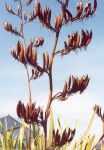Tāpoto
| Cultivar No | 27 | |
|---|---|---|
| Source | Taihoa Pa, Hawke´s Bay. | |
| Description | A real tīhore variety and one of the favourites of Hawke's Bay Māori. Once prevalent where Havelock North now stands. Strong, straight, short narrow blades tapering to a sharp point. Pale yellow-green leaves with bright orange keel and margins. Very fine, tall flower stalks. Similar to Tākirikau, but generally smaller. Many early records enthuse about this harakeke. It was often given the synonym 'Oue' but is a very different harakeke to the 'Oue' in this collection. Recognised for its beautiful glossy fibre. Heaphy (Flax Commissioners Report 1870) says that "some of this flax was manufactured in France into fabrics, that resembled fine jean and silk in delicacy of gloss. The Oue is frequently planted by the natives in borders to divide small cultivations near a village, and where it is convenient for occasional use in mat-making. In this case it constitutes quite a property. It may be seen in the cultivations at Coromandel harbour, Kawhia, and the Waikato. |
|
| Uses | Muka variety. Strips easily and cleanly into long, shiny, white fibre, brittle but very strong. Very good piupiu harakeke. Dries very hard to a pale cream colour. Used for kaitaka, whāriki and kete. |
|
| Muka extraction | Muka extracts well, some leaf matter sticks to fibre. Para removes well. Fibre is dull and easily "fluffs" up when cleaned. Fibre feels strong. | |
| Raranga - unboiled | When softening, whenu often split lengthwise and edges fray. It performs like a typical muka flax, only fibre doesn't release well. Whenu once softened are waxy and keep tension well. Thick butt ends and thin tips make for uneven weaving. |





